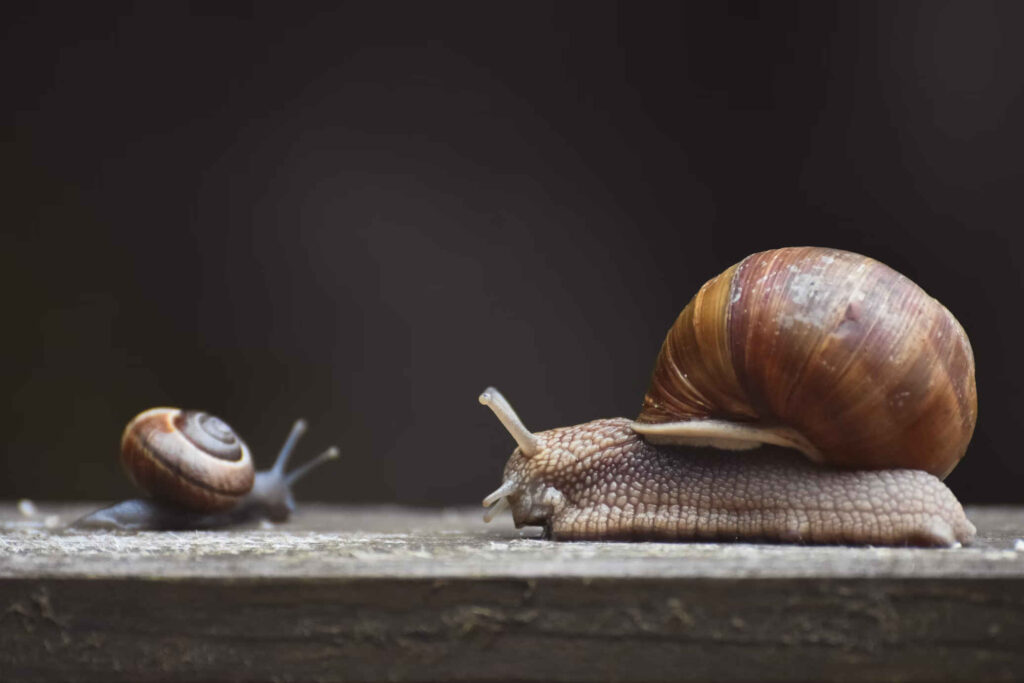Spring not only brings forth a new season of gardening it also is the starting time for a several pest problems.
If you dont want a season of problems you need to eliminate those pests which have survived winter, as soon as they appear.
That can be hard as you often do not realise they are in the garden till their populations are already out of control.
Perennial plants that had a problem last season will again have a problem this year if you dont take action now.
Slugs and snails are one of these problems which is made worse with ample rain and moisture around our gardens.
We don’t see much of these two pests during the day unless we discover one of their hiding places such as under a length of wood or behind a shrub against the fence.
They like to hide out in a cool moist place until after dark and then they can slide out to feed.
Interestingly they prefer rotting organic material over living foliage but can be partial to tender young foliage for a balanced diet.
If you venture out at night when its raining you maybe surprised to see hundreds of snails motoring all around the gardens.
In the morning you would be searching to find one out in the open.
Slugs not having the protection of their shell tend to live mostly in the soil where they venture out for a bit of a change of diet.
I have lived in places where in the beginning there have been no snails or slugs that I was aware of but after a while the odd ones would be found.
From that time it would only be another year or two for there to be masses of the slimy creatures.
How to deal with these two pests?
The traditional way would likely be to place slug baits (poisons) down such as Blitzem which contains Metaldehyde 15g/kg, a poison that dehydrates the slugs and snails and is dangerous to pets, children, wildlife and should not be applied to food crops; as many of the suppliers warn.
Baysol snail and slug bait is even a more potent poison which contains 20g/kg of Methiocarb being a contact and stomach poison.
Once again not something you want your pets getting into.
Quash is iron based pellets which are safe to use and not harmful to pets or your environment.
Slugs and snails cant stand iron which kills them when they eat the pellets.
Down side is all of these is they cost money and have a limited life in spring weather conditions.
Based on the iron aspect one could make a bait using sulphate of iron dissolved in water and added to say bran with a liberal sprinkling of yeast.
The yeast attracts, the bran is the carrier and the iron is the killer.
I have also mentioned in the past sprays of copper over and around plants you wish to protect from damage.
Slugs and Snails cannot handle copper which kills them if they come into contact with it.
Another method is using Ammonia in a 3 to 1 dilution ( 1 part Ammonia to 3 parts water) in a spray bottle,
this kills the slugs and snails straight away with no harm to plants or the soil.
I have also used it on other insects like cockroaches and earwigs and it worked just as well.
Put some plywood down to give the slugs somewhere to hide during the day, this works very well, and you are likely to find slugs and snails every day you turn over the wood.
Just give them a spray wait a couple of minutes then turn over the wood so the dead slugs are under the wood, this acts like bait to catch more slugs.
You will notice that there are a lot less slugs and snails on your plants after doing this for a week.
It takes only a little bit of effort, going out to buy a bottle of ammonia, laying out a few bits of 3ply or similar and then a one litre trigger spray bottle; 250mls of ammonia and 750mls of water. Shake before each use.
I love the idea of using on pests such as cockroaches and earwigs as I am often asked a solution to control them.
Take care spraying over plants till you know if any harm is done.
I have also this week had a number of questions about codlin moth control in apples, pears and walnuts.
I have learnt from gardeners that sprinkling Neem Tree Granules under the trees at this time can help with control.
A lot of the moths are under the trees in the soil pupating waiting to emerge when the apples have formed and conditions are favourable.
This being the case the Neem Granules smell as they break down which will confuse them.
When they emerge as moths, they will not sense/smell the tree above. Sitting on the ground is dangerous as the birds will find them and eat them.
Some gardeners have also taken my suggestion of making little bags out of curtain netting and filling them with Wallys Neem Tree Granules before hanging in the tree on the outer branches at the four cardinal points.
These also create a smell that camouflages the smell of the fruit which means the moths do not know there are any fruit there so fly on by.
According to reports back, the method has been very successful and works well against the dreaded Guava moths also.
Another gardener told me that she sliced open used tea bags, took out the tea leaves and placed Wally Cat Repellent into the bags and stapled them closed.
The smell from these hanging in the tree would be a higher smell that the granules.
I was told it worked 100% no damaged fruit.
Next place a small container of treacle in an onion bag and hang in the tree. This acts as a pheromone trap for the male moths.
Check you trap every few days and when there are noticed a few moths, you know that they are active.
Start spraying the young apples with Wallys Super Neem Tree Oil with Raingard every 14 days till no more activity is noticed in the treacle.
Note that is spraying the fruit only, not the whole tree.
Easy and once again inexpensive without harming honey bees or bumble bees.
It is a good practice this time of the year to make up a spray using Wallys Super Neem Tree and Wallys Super Pyrethrum and go around spray your garden plants over and under the foliage.
Only do this late in the day when the sun is low on the horizon before dusk.
Never do on an overcast day as the UV can with the oil damage foliage and the Pyrethrum will be quickly broken down by the UV.
Another tip; it is better to water in the morning (using filtered water without the chlorine) rather than late in the day as at night with moisture around and cooler temperatures then diseases can establish.
Image credit: Alexas_fotos
Order from www.0800466464.co.nz.
Products mentioned are from Wallys Range of products and can be found in some garden shops or by Mail Order on www.0800466464.co.nz
Problems ring me at: Phone 0800 466464
Garden Pages and News at www.gardenews.co.nz
Shar Pei pages at www.sharpei.co.nz
Mail Order products at www.0800466464.co.nz

